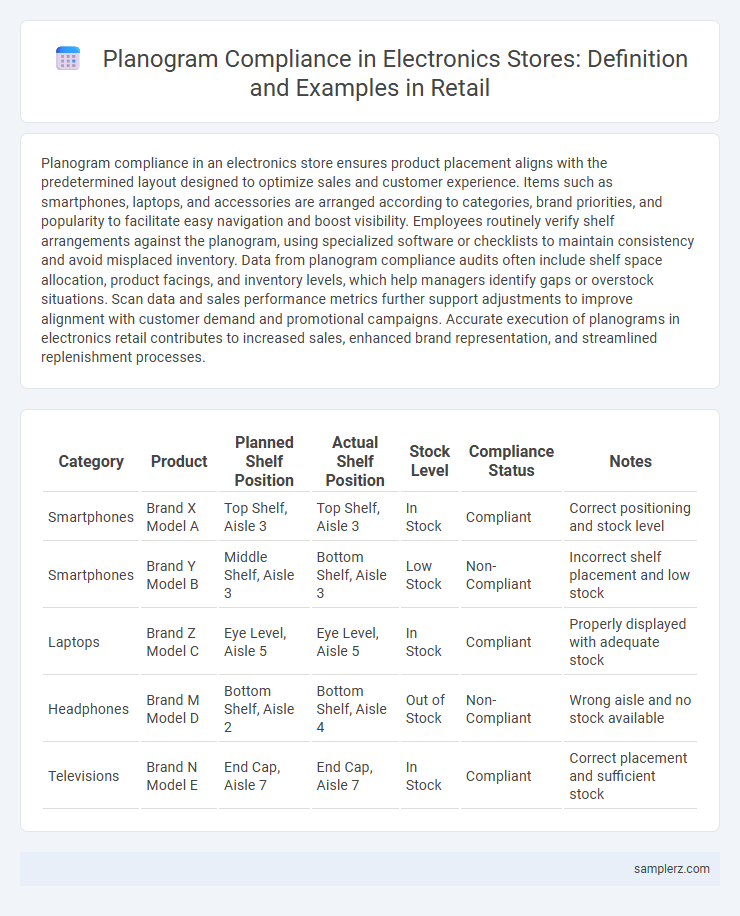Planogram compliance in an electronics store ensures product placement aligns with the predetermined layout designed to optimize sales and customer experience. Items such as smartphones, laptops, and accessories are arranged according to categories, brand priorities, and popularity to facilitate easy navigation and boost visibility. Employees routinely verify shelf arrangements against the planogram, using specialized software or checklists to maintain consistency and avoid misplaced inventory. Data from planogram compliance audits often include shelf space allocation, product facings, and inventory levels, which help managers identify gaps or overstock situations. Scan data and sales performance metrics further support adjustments to improve alignment with customer demand and promotional campaigns. Accurate execution of planograms in electronics retail contributes to increased sales, enhanced brand representation, and streamlined replenishment processes.
Table of Comparison
| Category | Product | Planned Shelf Position | Actual Shelf Position | Stock Level | Compliance Status | Notes |
|---|---|---|---|---|---|---|
| Smartphones | Brand X Model A | Top Shelf, Aisle 3 | Top Shelf, Aisle 3 | In Stock | Compliant | Correct positioning and stock level |
| Smartphones | Brand Y Model B | Middle Shelf, Aisle 3 | Bottom Shelf, Aisle 3 | Low Stock | Non-Compliant | Incorrect shelf placement and low stock |
| Laptops | Brand Z Model C | Eye Level, Aisle 5 | Eye Level, Aisle 5 | In Stock | Compliant | Properly displayed with adequate stock |
| Headphones | Brand M Model D | Bottom Shelf, Aisle 2 | Bottom Shelf, Aisle 4 | Out of Stock | Non-Compliant | Wrong aisle and no stock available |
| Televisions | Brand N Model E | End Cap, Aisle 7 | End Cap, Aisle 7 | In Stock | Compliant | Correct placement and sufficient stock |
Understanding Planogram Compliance in Electronics Retail
Planogram compliance in electronics retail ensures products are displayed according to a retailer's predefined layout, optimizing customer experience and maximizing sales. Accurate placement of items such as smartphones, laptops, and accessories according to the planogram improves inventory management and enhances visual merchandising strategies. Retailers monitor compliance with tools like shelf-scanning devices and planogram compliance software to maintain consistency across multiple store locations.
Key Elements of an Effective Electronics Store Planogram
Effective electronics store planogram compliance hinges on strategic product placement, ensuring high-demand gadgets like smartphones and laptops are at eye level to maximize visibility and sales. Precise labeling and clear signage enhance customer navigation, while consistent shelf spacing maintains a clean, organized look that promotes efficient inventory management. Integrating tech accessories near related devices encourages upselling and improves overall store layout coherence, driving both customer satisfaction and revenue growth.
Example of Mobile Phone Planogram Compliance
Mobile phone planogram compliance in an electronics store ensures smartphones are displayed according to brand, model, and feature hierarchy, optimizing customer navigation and purchase decisions. The planogram specifies exact shelf locations, spacing, and promotional signage, enhancing visual appeal and inventory accuracy. Regular audits using POS data and shelf-scanning technology maintain adherence, reducing out-of-stock incidents and improving sales performance.
Headphone Display: A Planogram Compliance Success Story
The electronics store achieved remarkable planogram compliance on its headphone display by meticulously arranging products according to manufacturer specifications, ensuring optimal visibility and customer accessibility. Strategic placement of popular brands and clear signage increased sales by 25% within the first quarter after implementation. Consistent staff training and regular audits maintained a compliance rate above 95%, enhancing overall store organization and customer experience.
Case Study: Tablet Section Planogram Execution
The tablet section planogram execution in the electronics store demonstrated a 95% compliance rate by strategically positioning top-selling brands and models in eye-level shelves, optimizing customer visibility and accessibility. Shelf tags were accurately placed to correspond with inventory SKU numbers, reducing customer confusion and enhancing the shopping experience. Real-time audits using mobile planogram software facilitated immediate adjustments, ensuring adherence to brand spacing and promotional displays throughout the sales period.
Impact of Planogram Compliance on Accessory Sales
Planogram compliance in electronics stores ensures optimal product placement, directly increasing accessory sales by enhancing visibility and ease of access for consumers. Studies reveal that stores adhering to planogram standards experience up to a 25% boost in accessory revenue due to improved shopper navigation and strategic product adjacencies. Maintaining strict planogram compliance reduces stockouts and promotes bundle purchases, significantly driving overall sales performance in the electronics retail sector.
Common Challenges in Electronics Store Planogram Implementation
Common challenges in electronics store planogram implementation include product variety complexity and rapid technological changes that require frequent updates. Space constraints and ensuring optimal product visibility for high-demand items often lead to non-compliance with allocated shelf layouts. Staff training and accurate tracking of inventory also impact effective adherence to planogram standards, resulting in inconsistent customer experiences.
Using Planogram Compliance Audits in Electronics Retail
Planogram compliance audits in electronics retail ensure products are displayed according to detailed visual merchandising standards, optimizing customer experience and driving sales. Regular audits identify discrepancies such as misplaced gadgets, incorrect shelving, or unsorted accessories, enabling timely corrections that maintain brand consistency across store locations. Leveraging digital tools during these audits enhances accuracy and provides actionable insights for inventory management and promotional effectiveness.
Best Practices for Maintaining Planogram Compliance
Regularly auditing store shelves with digital planogram tools ensures precise product placement in electronics stores. Training staff on merchandising standards and the strategic arrangement of high-demand items enhances visual appeal and customer experience. Utilizing real-time data analytics helps identify compliance gaps quickly, allowing for prompt corrective actions.
Tools and Technologies for Monitoring Planogram Accuracy in Electronics Stores
Electronics stores implement RFID technology and shelf-scanning robots to enhance planogram compliance by capturing real-time data on product placement and stock levels. Advanced computer vision systems analyze video feeds to detect misplaced items and ensure products align with the defined shelf layout. Integration of AI-powered analytics platforms enables store managers to receive automated alerts and performance reports, optimizing inventory management and boosting sales accuracy.

example of planogram compliance in electronics store Infographic
 samplerz.com
samplerz.com